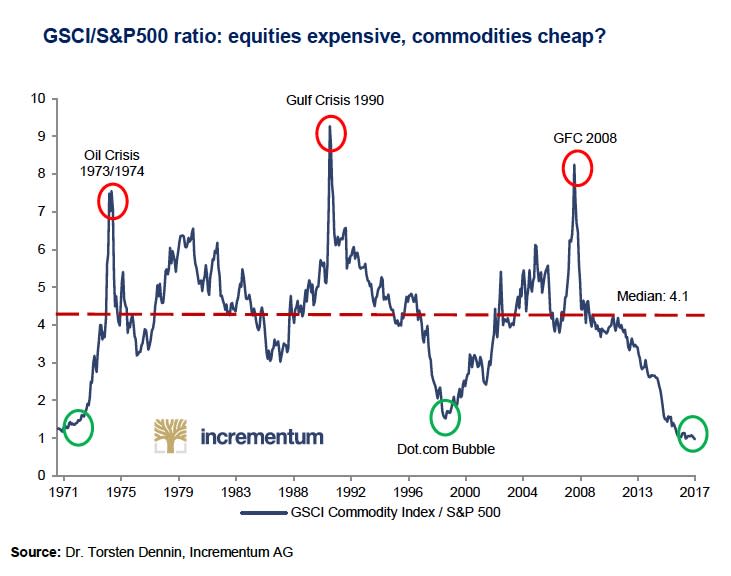When reality gets caught up


After the market has ignored the seriousness of the trade war for several months, reality seems to have finally caught up with the investors. From having continued to push up the price of assets to near-new all-time highs, the stock market now falls after expectations that the trade war will come to a solution will not be met.
After the market has ignored the seriousness of the trade war for several months, reality seems to have finally caught up with the investors. From having continued to push up the price of assets to near-new all-time highs, the stock market now falls after expectations that the trade war will come to a solution will not be met.
However, the stock market is still far from cheap just as the trade conflict is far from a solution. Thus, the risk is still high. But, this is another reality we should focus on today. Below we see the ratio between the GSCI Commodity index and the S&P500. When the blue line in the graph is high, this is usually a good sign for shares, which means that shares in relation to raw materials are cheap. When the blue graph, which now stands at record low levels, the situation looks all the better for commodities, but worse for stocks.

On two previous occasions since 1970, there have been good positions to re-allocate their capital from shares to commodities. One situation, in 1971, when President Nixon decided that the United States would leave the gold standard, extended until 1974 when the GSCI Commodity index rose 371 percent during the period, while the S & P500 fell by more than 50 percent over the same period. The other attractive situation was in 1999, during the IT bubble, when commodities were last evaluated as low in relation to shares as today. Between 1999 and 2008, GSCI Commodity increased fourfold, by 454 percent, while shares, despite a bull market between the IT bubble and the financial crisis, first fell by almost 50 percent between the peak 1999 to the bottom of 2002, then rising by over 60 percent ahead until 2007. If one had instead invested in raw materials during the same period, the result would have been better. Today, the situation looks equally interesting, if not even better.
Bull & Bear-Certificates
Stocks are ONE option, not the only one
The myth that shares are the only and best option is widespread among private savers and today few investors are diversifying their portfolios with just raw materials. Shares are ONE good option, but not the only one. And for those who are interested in actively managing their portfolio, raw materials are also a good alternative, perhaps even better than shares right now.
However, it is not about choosing either. A well-diversified portfolio should be just that - diversified. This means that even if shares in relation to raw materials are expensive right now, this does not mean that raw materials are the only thing that should be in a portfolio. Instead of trying the timea markets, there may be an idea in thinking about how much of your total portfolio you should allocate to raw materials, and how much should remain in stocks.
Depending on whether you want to take a long or short-term position in the commodity market, there are different ways of exposure. The volatility of soybeans has been high due to the trade war, and as long as it continues, the price will also be affected. In combination with swine flu that has taken cabbage of one third of China's pigs, the demand for soybeans falls for several reasons. This leads to short-term or long-term short-term speculation being more interesting rather than a long-term position in the raw material. For those who instead seek a long-term investment in raw materials, the inflation-proof metal gold is an asset that is popular among many investors. For more short-term positions, silver, or gold on steroids, which the gray cousin is also called, is a candidate to look at to the portfolio.
A worried and highly valued stock market does not mean that you have to see your invested capital disappear. Instead, it gives you the opportunity to search for others, perhaps lower valued, asset classes that can create additional opportunities for your portfolio in the long term.
@Anna Svahn
This information is in the sole responsibility of the guest author and does not necessarily represent the opinion of Bank Vontobel Europe AG or any other company of the Vontobel Group. The further development of the index or a company as well as its share price depends on a large number of company-, group- and sector-specific as well as economic factors. When forming his investment decision, each investor must take into account the risk of price losses. Please note that investing in these products will not generate ongoing income.
The products are not capital protected, in the worst case a total loss of the invested capital is possible. In the event of insolvency of the issuer and the guarantor, the investor bears the risk of a total loss of his investment. In any case, investors should note that past performance and / or analysts' opinions are no adequate indicator of future performance. The performance of the underlyings depends on a variety of economic, entrepreneurial and political factors that should be taken into account in the formation of a market expectation.